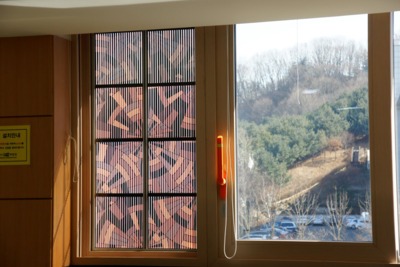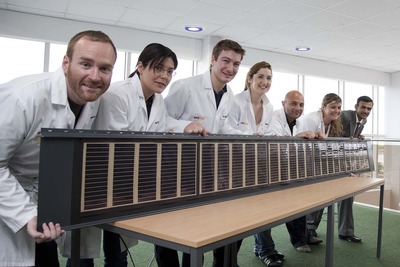Sustaining a clean energy future
Solar photovoltaic (PV) electricity continues to grow rapidly across the world and is now, after hydro and wind power, the third most important renewable energy source in terms of globally installed capacity. PV represented about 0.5% of global electricity demand and 1% of peak power demand at the end of 2011^.
The growth of solar photovoltaic (PV) electricity is particularly significant as much of it has come from Europe, responsible for 75% of all new capacity in 2011, during a time of economic crisis and industry consolidation. This shows us that with the right policy conditions in place, PV can progress to become a mainstream energy source even in difficult market conditions and the global outlook for the sector is very positive.
While Europe’s PV growth far outpaces the rest of the world, other markets including China, Japan, India, the USA and Australia are starting to tap into their potential while the large ‘sunbelt’ regions such as Africa, the Middle East and Latin America should soon begin development.
According to the European Photovoltaic Industry Association’s Global Market Outlook for Photovoltaics Until 2016, Australia’s speed of PV growth to 774 MW in 2011 was not sustainable and was too complicated through inconsistent and varied state-based feed-in-tariff (FiT) policies^ which are now all wound back or closed.
What is clear is that PV has great benefits for becoming a substantial energy source for the country; however, key to PV becoming a viable and competitive energy source over the long term is a robust framework that is not impacted by political uncertainty.
Currently, Australia is on track to meet its renewable energy targets of 20% for 2020 and some experts are predicting we’ll reach as high as 26% by that time.
With the current forecasts for rising electricity prices in Australia through to 2015, wind and solar power are becoming more economical, especially in certain ‘sweet spots’ on the grid, where there is increased demand (such as for a new residential or industrial development) and where it is possible to delay grid augmentation by installing embedded generation. Indeed, there are many places where the embedded renewable energy installation will be less expensive than grid augmentation; for example, installing additional grid infrastructure such as upgrading the network distribution substation or replacing high-voltage power lines.
The grid is the main issue which could limit growth in the adoption of renewable energy technologies. The question of who, between the distribution companies and retail utilities, should bear the interconnection costs needs to be resolved. As embedded renewable energy installations increase (in some places residential PV has reached 30%), there is a need to augment connection node infrastructure, and the issue of who pays for that is currently unresolved.
The solution to the grid infrastructure issue will need federal and state government cooperation. It could include government directing distributors to deal with these grid issues and improve access to the grid. Pricing controls through the Australian Competition and Consumer Commission, which is a statutory authority established to promote competition and fair trade in the marketplace, will be important.
Australia’s challenge is to understand the supply chain and thus optimise the benefits to our broad economy from the renewable energy market.
We need to take examples from countries such as Germany and Italy who have fully embraced renewable energy policies and technologies, particularly in light of the Fukushima nuclear disaster, to drive the use of alternative energy sources among consumers and business alike.
In addition to government policies and financial incentives, we should also, as a country, be embracing innovation and technology that will enable us to take the next step to turn our buildings and vehicles into efficient and inexpensive power generators.
At Dyesol, we are currently working with a number of multinational partners around the globe to integrate and embed our Dye Solar Cell (DSC) technology into products for the building supply sector (such as windows and steel roofing material). DSC is photovoltaic enabling technology mimicking photosynthesis that generates electricity in a wider range of light conditions (including cloudy days, hazy or polluted days, at dawn and dusk) than its traditional photovoltaic predecessor and is less sensitive to the angle of incidence of light. This means DSC-enabled products can be installed vertically into a facade on the side of a building that doesn’t receive direct sunlight, as is the case in many crowded urban environments.
By partnering with world-leading building materials manufacturers such as Tata Steel Europe in the UK and Pilkington North America in the USA (through the joint venture Dyetec Solar), we are on track to enable them to offer DSC solutions for commercial and residential buildings in the next few years.

Globally, the PV industry generated $82 billion in revenues in 2010 and energy demand is projected to increase by 49% over the next 30 years. There is huge demand for additional sources of energy and DSC is best placed to answer this demand, particularly in cities as DSC works well in low-light and dappled conditions typical of urban and city environments, making it an ideal renewable resource for closely packed buildings.
With buildings themselves using more than 71% of all energy produced in the US in 2008 for example, being able to turn buildings into their own power generators with DSC photovoltaic enabled building products producing energy right at the point of use is an excellent solution to a growing problem of the often very distant location of solar farms with the inherent high costs of transmission losses and grid extension infrastructure. Integrating DSC photovoltaic power into the built environment creates a new dynamic in supply and use of power.
In a marketplace driven by many factors such as increasing electricity price, security of supply, safety of power generation and distribution, and global warming, it is estimated that the building integrated photovoltaic market will reach $6.4 billion by 2016 according to industry analyst NanoMarkets.
In the UK, Dyesol and partn er Tata Steel Europe have successfully completed the £11m pilot production phase of integrating DSC on steel sheets in a coil-coating production line. The project has produced the world’s largest dye-sensitised photovoltaic module on steel roofing material. The module is over 3 m in length and approximately 1 m2 in area and represents an important step in the development of large-scale micro and local energy generation capability within the infrastructure of buildings.
er Tata Steel Europe have successfully completed the £11m pilot production phase of integrating DSC on steel sheets in a coil-coating production line. The project has produced the world’s largest dye-sensitised photovoltaic module on steel roofing material. The module is over 3 m in length and approximately 1 m2 in area and represents an important step in the development of large-scale micro and local energy generation capability within the infrastructure of buildings.
Creation of the DSC-enabled roofing prototype has demonstrated the potential for DSC on steel roofing applications and for manufacturing processes using continuous printing and coating processes, for scaling up the production of steel strips onto which a dye-sensitised photovoltaic coating has been printed. Produced as a single length of coated steel, the breakthrough brings closer to commercial realisation the ambition to develop a manufacturing process that can produce long roofing panels with an integrated DSC photovoltaic functionality.
Across the world, we are working with leading research partners and with the support of governments to develop, improve and commercialise high-performing, low-cost DSC technology for use across the built environment.
We hope that the success we achieve abroad in other countries will be replicated here in Australia so all Australians can enjoy the benefits of a sustainable, clean energy from our most powerful source - the sun.
Partnership brings innovative fuel solutions to Gippsland
A study by European Energy Australia and Opal at the latter's Maryvale Paper Mill will assess...
Data centres — a missed opportunity for sustainability
The question is no longer whether we need data centres, but how we plan, locate and govern...
Sodium-ion battery may provide greener energy
Scientists say sodium-ion batteries may be the answer to the future of sustainable energy storage...








